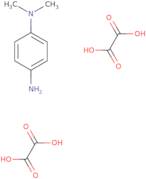N,N-Dimethyl-p-phenylenediamine oxalate
CAS: 62778-12-5
Ref. 3D-MCA77812
| 10g | Discontinued | ||
| 25g | Discontinued | ||
| 50g | Discontinued | ||
| 100g | Discontinued | ||
| 250g | Discontinued |
Product Information
- 1,4-Benzenediamine, N,N-dimethyl-, ethanedioate (2:1)
- 1,4-Benzenediamine, N<sup>1</sup>,N<sup>1</sup>-dimethyl-, ethanedioate (2:1)
- 1,4-benzenediamine, N~1~,N~1~-dimethyl-, ethanedioate (2:1)
- 4-Ammoniophenyl(dimethyl)ammonium oxalate
- N,N-Dimethyl-1,4-phenylenediamine oxalate
- N,N-Dimethylbenzene-1,4-diamine ethanedioate (2:1)
- N<sup>1</sup>,N<sup>1</sup>-Dimethyl-1,4-benzenediamine ethanedioate (2:1)
- P-N,N-Dimethylphenylenediamine Oxalate
- N1,N1-Dimethyl-1,4-benzenediamine ethanedioate (2:1)
- 1,4-Benzenediamine, N1,N1-dimethyl-, ethanedioate (2:1)
- See more synonyms
Photorhabdus is a genus of Gram-negative, rod-shaped bacteria that are found in soil and water. Photorhabdus species are opportunistic pathogens and can cause severe wound infections after penetrating the skin. This genus includes Photorhabdus luminescens, which was first isolated from the South African soil in 1943. The type strain of this bacterium is ATCC BAA-835. Photorhabdus luminescens is able to survive abiotically by forming a protective cyst that allows it to resist extreme environmental conditions such as freezing, high heat, and desiccation. It has been shown that they produce a number of virulence factors including proteases, lipases, and superantigens. These virulence factors contribute to the pathogenicity of this bacterium by causing cell lysis and tissue necrosis when they enter the body through wounds or other openings in the skin.





